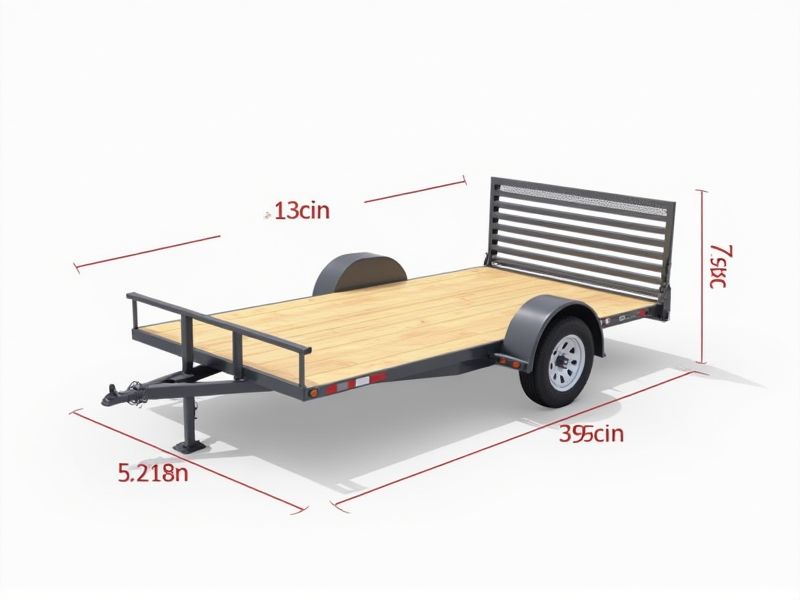
When choosing a utility trailer, understanding standard dimensions can help you find the right fit for your needs. Common small utility trailers typically measure around 4 feet by 6 feet or 5 feet by 8 feet, making them ideal for hauling garden supplies, small equipment, or bikes. Larger models, like 6 feet by 12 feet or 7 feet by 14 feet, are better for heavier loads such as ATVs or building materials. Always check the trailer's weight capacity and ensure it matches your vehicle's towing limits for safe and efficient transport.
Length
Utility trailers typically range from 4 to 20 feet in length, accommodating various types of cargo such as vehicles, equipment, and household goods. A 5x8-foot trailer is perfect for smaller loads, while a 7x14-foot option offers increased capacity for larger items. The industry standard for weight capacity varies, but many trailers can support loads between 1,500 to 7,000 pounds, making them versatile for personal or business use. When selecting a utility trailer, consider your specific hauling needs to ensure optimal length and weight specifications match your requirements.
Width
The standard width for utility trailers typically ranges from 60 inches to 102 inches, catering to various load requirements. A 76-inch width is common for mid-sized trailers, providing ample space for transporting standard-sized cargo. Greater width allows you to carry wider items, accommodating equipment like ATVs or lawnmowers. Understanding these dimensions ensures that your utility trailer meets specific transport needs effectively.
Height
The standard height for utility trailers typically ranges from 12 to 24 inches. Choosing the right height is crucial for easy loading and unloading, especially for items like ATVs, furniture, or equipment. A lower trailer height can facilitate access for heavier loads, while a higher height may offer better ground clearance for off-road use. Ensure the trailer's height aligns with your vehicle's towing capacity, which usually falls between 2,000 to 10,000 pounds depending on the model.
Gross Vehicle Weight Rating
A standard utility trailer typically features a Gross Vehicle Weight Rating (GVWR) ranging from 1,500 to 14,000 pounds, depending on the model and intended use. This rating is crucial for ensuring that the trailer can safely carry the weight of both cargo and the trailer itself without risking structural integrity. Many utility trailers come equipped with specific features like reinforced frames, heavy-duty axles, and adjustable hitches designed to enhance load capacity and stability. When selecting a utility trailer, it's essential to match the GVWR to your towing vehicle's capacity and your intended load to ensure safe transportation.
Axle Count
A typical utility trailer usually features two axles, which provide a balanced weight distribution and enhanced stability for transporting goods. With a load capacity often exceeding 3,500 pounds, dual axles enable you to carry larger and heavier loads safely. In contrast, single-axle trailers are more suitable for lighter loads, typically under 2,000 pounds, making them ideal for smaller tasks such as gardening or light hauling. You can enhance your towing experience by selecting a trailer with the appropriate axle count based on your hauling needs and vehicle compatibility.
Payload Capacity
Utility trailers are typically designed with a payload capacity that ranges from 1,500 to 7,000 pounds, catering to varying transport needs. The payload capacity is influenced by factors such as the trailer's construction material, dimensions, and axle ratings. For instance, a heavier-duty utility trailer with a steel frame may comfortably support a higher payload compared to a lighter aluminum model. Understanding these specifications ensures you choose a utility trailer that efficiently accommodates your hauling requirements without compromising safety or performance.
Deck Material
The standard utility trailer often features a deck constructed from treated wood or durable steel, both offering distinct advantages based on your hauling needs. Treated wood provides natural resistance to moisture and pests, ensuring longevity, while steel decks boast superior strength and are ideal for heavier loads. Typically, the deck size ranges from 4x8 feet to 6x12 feet, accommodating various cargo dimensions. When selecting a utility trailer, consider factors such as weight capacity, deck material, and intended use to ensure optimal performance and durability.
Hitch Type
Utility trailers primarily vary based on hitch types, which significantly impact towing capacity and compatibility with different vehicles. The most common hitch types are the ball hitch, which can handle loads up to approximately 5,000 pounds, and the pintle hitch, designed for heavier loads exceeding 10,000 pounds. Weight distribution hitches are also prevalent, distributing the trailer's weight evenly to enhance stability and control while towing. Selecting the appropriate hitch type is crucial for ensuring safety and optimal performance of your utility trailer on the road.
Tire Size
Utility trailers typically come with tire sizes ranging from 13 to 15 inches in diameter, depending on the trailer's weight capacity and intended use. A common tire size for a standard utility trailer is 14 inches, providing a balance between load-bearing capability and ease of towing. Selecting the right tire size is crucial for optimizing your trailer's performance and ensuring safe handling during transport. Regularly checking tire pressure, which should be between 40 and 65 PSI, can significantly extend the lifespan of your trailer's tires and enhance fuel efficiency.
Brake System
A utility trailer's brake system is crucial for ensuring safety and control, particularly when hauling heavy loads, which can range from 1,500 to 3,500 pounds depending on the trailer type. There are two primary brake systems found in utility trailers: electric brakes, which provide more precise stopping power and are often preferred for larger loads, and surge brakes, which are activated by the trailer's inertia during braking. Proper maintenance of the brake components, including checking brake pads, wiring, and hydraulic fluid levels, is essential to maintain efficiency and prevent accidents. Familiarizing yourself with your trailer's specific brake requirements and regulations, such as those mandated by the DOT, can enhance safety and compliance on the road.
